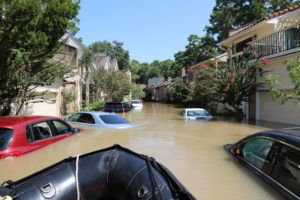They had to find new words.
In advance of Hurricane Harvey‘s landfall, the meteorologists at the National Weather Service in League City, Texas, felt they needed to break from the usual language they use to communicate the dangers of the storm and the rain it would bring.
The Galveston County Daily News reports they settled on a handful of words.
Catastrophic. Epic. Unprecedented.
“There was a lot of thinking on how to communicate all that,” said Dan Reilly, the warning coordination meteorologist at the League City office. “We wanted to communicate that this was going to be a big deal.
“We were pulling from the dictionary.”
 View from FEMA’s Urban Search and Rescue Virginia Task Force Two (VA-TF2) searching neigborhoods inside Houston for survivors after flooding caused by Hurricane Harvey
View from FEMA’s Urban Search and Rescue Virginia Task Force Two (VA-TF2) searching neigborhoods inside Houston for survivors after flooding caused by Hurricane Harvey
Meteorologists aren’t normally thought of as first responders. But as Harvey bore down on the Texas Coast, and then meandered northeast over Houston and Beaumont, the dozen or so meteorologists that work out of the second-floor office in the Galveston County Emergency Management office building found themselves literally in the middle of the epic storm.
The weather service provides forecasts for a 23-county area in Texas, including some of the worst-hit areas of the state, including Brazoria, Harris, Galveston and Chambers counties. The service has operated out of the office on FM 646 since 2005, but there has been a weather bureau in the Houston-Galveston area since as far back as 1881.
In all that time, there has never been quite a storm like Harvey, which set new rainfall records at 31 of the 46 gauges the weather services monitors.
Starting Aug. 24, the meteorologists were put on 12-hour shifts. By Aug. 25, the day before Harvey made landfall in Rockport, staff members were told to start being prepared to be trapped inside the office.
“We knew what we were going up against,” said Jeff Evans, the meteorologist in charge of the office. “I was messaging the staff to bring changes of clothes, bring food in case we were going to get stuck here.”
They kept on those shifts for nearly a week. One of the primary jobs of the office was keeping local officials updated on the movements of the storm and producing updated detailed forecasts three times a day.
The office also monitored their social media account, (at)NWSHouston, which started to be inundated with requests for help as the heaviest rains fell Saturday night. People who had not been able to reach 911 had turned to Twitter to ask for rescue.
“We were starting to get chats around midnight that people were having to go their attics for safety,” Evans said. “That’s when it hit home that people were probably dying.”
Most of the forecasters live with 8 miles of the office, where more than 4 feet of rain fell during the storm. Their homes were threatened, and while they were providing the world with updates about the system, their families were calling to provide them with updates about creeping floodwaters.
“There was very personal stake for a lot of us,” Reilly said. His mother-in-law lives along Mary’s Creek in Friendswood, where some of the heaviest rains fell. “Loved ones, friends were worried about their own personal safety. That’s not something we deal with every day.”
There were two people in the office when the heaviest rain started, but others found their way into the office in the following days. There were plans in place to ask the weather service office in Tallahassee, Florida, to assist with forecasting, but they never needed to be called upon.
Life in the weather center got cramped and crowded. Staff members tried to sleep when and where they could, but even finding a comfortable spot presented challenges. The storage room that had been converted into a bunk room has a motion sensor light, for instance, meaning any tossing and turning brought a fluorescent flash.
The meteorologists who were off-duty had to learn how to turn themselves “off,” Evans said, and to ignore the instinct of checking the news and latest forecasts, which were available just steps away.
The cramped quarters did create a sense of closeness in the group.
That was helpful for meteorologist Katie Magee, whose first day at the office was on the Monday before the hurricane made landfall.
“I was literally trying to learn people’s names,” she said. Magee couldn’t get to her home for six days.
The office’s work didn’t end when the rain stopped and the floodwaters receded. Teams of forecasters went out into flood-ravaged communities to collect data and complete post-storm reports.
For some of the forecasters, it was the first time they were able to appreciate the full scope of the damage.
“There was one point when we went through a neighborhood, and it looked like a river had wiped through the first floor of everyone’s homes,” said meteorologist Nikki Hathaway. “Things were everywhere; there was an older lady just picking things up in her front yard. It was the first time I actually cried.”
In the weeks that followed, counselors came to the office to make sure the group was able to process the stress and trauma they had gone through.
“We all had Harvey in our dreams for weeks,” Evans said. “We had to be able to process it individually. It was a tough thing for a lot of folks.”
Evans said the forecasters – all of them self-professed weather geeks – gained a new appreciation of nature’s power, and were proud of the work they did during the storm.
“We count the people we lose, but we can’t count the number of people we saved,” he said. “It’s an immeasurable number, but it’s the one we’re most proud of.”
Was this article valuable?
Here are more articles you may enjoy.

 Tariff Panic Spurs Fastest Retail Sales Growth in Two Years
Tariff Panic Spurs Fastest Retail Sales Growth in Two Years  Tariffs Threaten to Push US Home Insurance Rates Even Higher
Tariffs Threaten to Push US Home Insurance Rates Even Higher  Nearly 24 Firms Seek Deal With CFTC to Settle Enforcement Cases
Nearly 24 Firms Seek Deal With CFTC to Settle Enforcement Cases  ‘Everything Is on the Table’ in NYC Helicopter Probe, NTSB Says
‘Everything Is on the Table’ in NYC Helicopter Probe, NTSB Says 